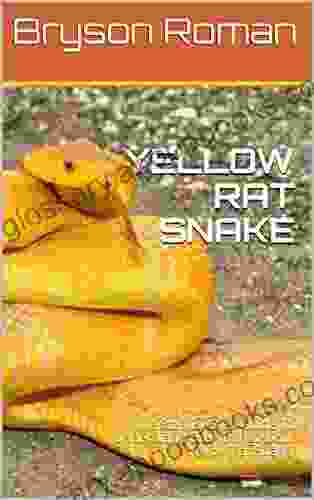The Ultimate Guide: Uncover Everything About the Yellow Rat Snake


4.3 out of 5
| Language | : | English |
| File size | : | 1606 KB |
| Text-to-Speech | : | Enabled |
| Screen Reader | : | Supported |
| Enhanced typesetting | : | Enabled |
| Print length | : | 19 pages |
| Lending | : | Enabled |
Yellow Rat Snakes, scientifically known as Pantherophis alleghaniensis, are non-venomous constrictor snakes native to North America. Known for their striking yellow and black patterns, these fascinating creatures are often encountered in a variety of habitats. In this comprehensive guide, we will delve into the world of Yellow Rat Snakes, exploring their appearance, behavior, habitat, diet, reproduction, threats, conservation, and even some captivating facts.
Appearance
Yellow Rat Snakes are medium-sized snakes, typically ranging from 3 to 6 feet in length. They possess a slender body with a triangular-shaped head, distinct from their necks. The scales of these snakes are smooth and glossy, giving them a sleek and shiny appearance.
True to their name, Yellow Rat Snakes are adorned with a vibrant yellow coloration, often accompanied by black or brown blotches or bands. These patterns vary in shape and size, making each snake unique. The underbelly is typically a cream or white color, sometimes with dark markings.
Behavior
Yellow Rat Snakes are generally docile and non-aggressive towards humans. They are primarily nocturnal, spending the day concealed in burrows, under rocks, or in dense vegetation. During the night, they actively hunt for prey.
When threatened, Yellow Rat Snakes may flatten their bodies and vibrate their tails to deter predators. They are also known for their defensive musk, a foul-smelling substance released through their cloaca to ward off potential threats.
Habitat
Yellow Rat Snakes are found in a wide range of habitats, including forests, woodlands, grasslands, meadows, and even urban areas. They prefer areas with ample cover and a reliable water source.
These snakes are semi-arboreal, meaning they spend part of their time in trees and shrubs. They are excellent climbers and often utilize branches and tree hollows for shelter.
Diet
Yellow Rat Snakes are primarily carnivorous, with a diet consisting mainly of rodents. They are known to consume rats, mice, voles, and other small mammals. Occasionally, they may also feed on birds, lizards, or even other snakes.
Using their keen senses, Yellow Rat Snakes locate their prey by sight and smell. They then use their strong muscles to constrict the animal, suffocating it before consuming it whole.
Reproduction
Yellow Rat Snakes reach sexual maturity around 2-3 years of age. They typically mate in the spring or early summer. During courtship, the male snake will follow the female and engage in a ritual known as 'tail-chasing.'
After mating, the female will lay a clutch of 5-20 eggs in a secluded location, such as a burrow or under logs. The eggs are incubated for approximately 6-8 weeks, after which the young snakes emerge.
Threats
Yellow Rat Snakes face several threats in their natural habitats:
- Habitat Loss: Destruction of forests and grasslands for development and agriculture reduces their available habitat.
- Road Mortality: Snakes are often killed by vehicles as they cross roads.
- Predation: Yellow Rat Snakes are preyed upon by larger predators, such as coyotes, hawks, and owls.
- Disease: Snakes are susceptible to various diseases, including respiratory infections and parasites.
Conservation
Conservation efforts are crucial for the protection of Yellow Rat Snakes. These measures include:
- Habitat Protection: Preserving and restoring natural habitats provides essential shelter and resources for the snakes.
- Wildlife Corridors: Creating wildlife corridors allows snakes to safely move between habitats, reducing road mortality and genetic isolation.
- Public Education: Raising awareness about the importance of Yellow Rat Snakes and dispelling misconceptions can foster appreciation for these creatures.
- Captive Breeding Programs: Captive breeding programs help maintain genetic diversity and support population recovery efforts.
Interesting Facts
- Yellow Rat Snakes can live for up to 20 years in the wild.
- They are excellent climbers and can reach heights of up to 100 feet in trees.
- Yellow Rat Snakes are immune to the venom of their own species.
- They have a unique ability to regurgitate their prey if threatened.
- Yellow Rat Snakes are beneficial to humans as they help control rodent populations.
Care
If you are considering keeping a Yellow Rat Snake as a pet, it is important to provide proper care:
- Enclosure: The enclosure should be spacious enough for the snake to move around comfortably and should include hiding spots and a water bowl.
- Temperature and Humidity: Maintain a temperature gradient within the enclosure, with a warm side of around 85-90°F and a cooler side of 75-80°F. The humidity should be around 50-60%.
- Diet: Feed your snake a diet of frozen or live rodents of appropriate size, once or twice a week.
- Handling: Handle your snake gently and support its body fully. Avoid handling too frequently, as this can stress the snake.
- Veterinary Care: Take your snake for regular veterinary checkups to ensure its health and well-being.
Yellow Rat Snakes are captivating creatures that play an important role in their ecosystems. Through this comprehensive guide, we have explored their appearance, behavior, habitat, diet, reproduction, threats, conservation, interesting facts, and even provided guidance on their care as pets. By understanding and appreciating these snakes, we can contribute to their preservation and ensure their continued existence in our world.
4.3 out of 5
| Language | : | English |
| File size | : | 1606 KB |
| Text-to-Speech | : | Enabled |
| Screen Reader | : | Supported |
| Enhanced typesetting | : | Enabled |
| Print length | : | 19 pages |
| Lending | : | Enabled |
Do you want to contribute by writing guest posts on this blog?
Please contact us and send us a resume of previous articles that you have written.
 Book
Book Novel
Novel Page
Page Chapter
Chapter Text
Text Story
Story Genre
Genre Reader
Reader Library
Library Paperback
Paperback E-book
E-book Magazine
Magazine Newspaper
Newspaper Paragraph
Paragraph Sentence
Sentence Bookmark
Bookmark Shelf
Shelf Glossary
Glossary Bibliography
Bibliography Foreword
Foreword Preface
Preface Synopsis
Synopsis Annotation
Annotation Footnote
Footnote Manuscript
Manuscript Scroll
Scroll Codex
Codex Tome
Tome Bestseller
Bestseller Classics
Classics Library card
Library card Narrative
Narrative Biography
Biography Autobiography
Autobiography Memoir
Memoir Reference
Reference Encyclopedia
Encyclopedia Ts Snow
Ts Snow Denise Gilmore
Denise Gilmore Mary Katherine Fons
Mary Katherine Fons Khalid Khan
Khalid Khan Shawn Wickens
Shawn Wickens Marsden Melanie Jennifer
Marsden Melanie Jennifer Denise Giardina
Denise Giardina Nathan Hystad
Nathan Hystad Elliott Lang
Elliott Lang Michael Jarvie
Michael Jarvie Raquel Frances
Raquel Frances Ken Voges
Ken Voges Deidre Bevers
Deidre Bevers Graeme Davis
Graeme Davis Sonia Sanchez
Sonia Sanchez Derrick Darby
Derrick Darby Laurie David
Laurie David Karen J Bun
Karen J Bun Theresa Anthony
Theresa Anthony Diane Rehm
Diane Rehm
Light bulbAdvertise smarter! Our strategic ad space ensures maximum exposure. Reserve your spot today!

 Stephen FosterReclaiming Lost Equality: A Journey Through Nicola Cornick's "Lost Equality...
Stephen FosterReclaiming Lost Equality: A Journey Through Nicola Cornick's "Lost Equality... Kirk HayesFollow ·15.7k
Kirk HayesFollow ·15.7k Don ColemanFollow ·16.3k
Don ColemanFollow ·16.3k Christian BarnesFollow ·8.6k
Christian BarnesFollow ·8.6k Ike BellFollow ·8.3k
Ike BellFollow ·8.3k Bradley DixonFollow ·11.9k
Bradley DixonFollow ·11.9k Thomas MannFollow ·12.4k
Thomas MannFollow ·12.4k Ernest ClineFollow ·15.6k
Ernest ClineFollow ·15.6k Charles BukowskiFollow ·15.7k
Charles BukowskiFollow ·15.7k

 Clarence Mitchell
Clarence MitchellCollection Of Handcrafted Plants For The Blackest Of...
Do you have a black...

 Edgar Hayes
Edgar HayesClassic Racing Mystery From The King Of Crime
Agatha Christie, the...

 Demetrius Carter
Demetrius CarterLafayette: Courtier to Crown Fugitive, 1757-1777
The Marquis de...

 Jared Powell
Jared Powell30 Gorgeous Sweaters, Cardigans, Hats, Toys & More:...
Immerse Yourself...
4.3 out of 5
| Language | : | English |
| File size | : | 1606 KB |
| Text-to-Speech | : | Enabled |
| Screen Reader | : | Supported |
| Enhanced typesetting | : | Enabled |
| Print length | : | 19 pages |
| Lending | : | Enabled |














